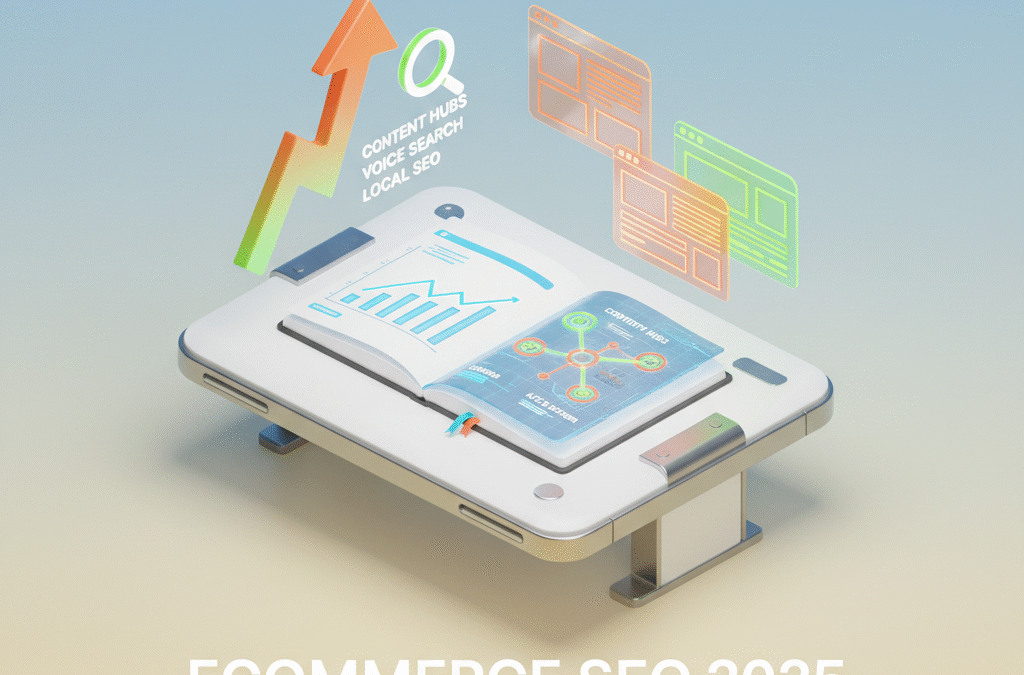Key Takeaways
- Over 80% of buying journeys now begin with search engines or AI answer tools.
- Most ecommerce stores are still optimizing for outdated search landscapes.
- Focusing solely on achieving the #1 ranking may overlook emerging customer behaviors.
- Potential customers are increasingly relying on AI tools like ChatGPT for product recommendations.
- Many ecommerce brands are missing out on exposure in AI-driven search results.
Table of Contents
- The New Reality: Why Ecommerce SEO Isn’t Optional in 2025
- What Makes Ecommerce SEO Services Different, And Why It Matters for Store Growth
- The Agentic Advantage: How ESSO Co’s Always-On AI Systems Change the Game
- The Agentic Advantage: ESSO Co’s Always-On AI Content Systems
- Ecommerce SEO Services Comparison: ESSO Co vs. Traditional Agencies vs. DIY
- How to Execute Ecommerce SEO Like a Pro: Actionable Frameworks
- Advanced Topics: AEO, GEO, and Winning the AI Answer Engine Game
- Case Studies and Proof: Compounding Growth in Action
- The 2025 Growth Checklist: How to Choose the Right Ecommerce SEO Partner
SEO Services for Ecommerce Stores: The 2025 Blueprint for Compounding Growth
Here’s what most ecommerce founders don’t realize: over 80% of buying journeys now start with search engines or AI answer tools, yet the majority of online stores are optimizing for yesterday’s search landscape. While you’re fighting for that coveted #1 ranking, your potential customers are asking ChatGPT “what’s the best [your product]” and getting recommendations that don’t include your brand.
I’ve spent the last 18 months helping 7 and 8-figure ecommerce brands navigate this shift, our portfolio alone represents over $250M in combined annual revenue. What I’ve learned is that seo services for ecommerce stores aren’t just evolving; they’re being completely rewritten by AI-powered search behaviors.
The brands winning in 2025 aren’t just ranking higher, they’re becoming the answers that AI engines recommend. They’re building always-on content systems that work for both Google’s blue links and ChatGPT’s recommendations. And they’re doing it with a speed and precision that manual SEO simply can’t match. If you’re ready to see how these strategies can transform your store, book a free AEO and SEO strategy call to get started.
The New Reality: Why Ecommerce SEO Isn’t Optional in 2025
Google’s AI Overviews now appear in 13% of all searches, double the rate from January 2024. Meanwhile, ChatGPT processes 2.5 billion prompts daily, rapidly approaching Google’s 14 billion daily searches. For ecommerce brands, this isn’t just a trend, it’s a fundamental shift in how customers discover and evaluate products.
Traditional SEO metrics like “ranking #1” are becoming less meaningful when customers never scroll past the AI-generated answer. I’ve seen Shopify stores with perfect technical SEO and top rankings lose 30% of their organic traffic because they weren’t optimized for answer engines. The buying intent is shifting toward trusted AI recommendations, peer reviews embedded in search results, and real-time product data that traditional SEO approaches can’t capture.
For DTC brands and Amazon sellers, this creates both urgency and opportunity. The stores adapting their seo services for ecommerce stores to include Answer Engine Optimization (AEO) are seeing compound growth, while those stuck in 2022 SEO tactics are watching their organic visibility erode, even with strong domain authority.
Quick Reality Check: If you search for your main product category right now, does your brand appear in Google’s AI Overview or get recommended when you ask ChatGPT for alternatives? If not, you’re invisible to a rapidly growing segment of buyers.
What Makes Ecommerce SEO Services Different, And Why It Matters for Store Growth

Ecommerce SEO isn’t just “regular SEO for online stores.” It’s a specialized discipline designed for high-SKU catalogs, multi-funnel customer journeys, and commerce platforms with unique technical constraints. While a standard website might have dozens of pages, ecommerce stores manage hundreds to hundreds of thousands of product pages, each requiring individual optimization while maintaining site-wide coherence.
The complexity multiplies when you factor in inventory fluctuations, seasonal product launches, faceted navigation systems, and the need to optimize for both branded and non-branded search terms across multiple product categories. Add marketplace integration (Amazon, Walmart, Etsy) and the requirement to avoid duplicate content penalties, and you’re operating in a completely different SEO environment.
| Criteria | Standard SEO | Ecommerce SEO |
|---|---|---|
| Page Volume | 10-100 pages | 100-100,000+ pages |
| Content Strategy | Broad, editorial | SKU-specific + category hubs |
| Technical Complexity | Moderate | High (facets, inventory, schema) |
| Revenue Attribution | Lead generation | Direct sales tracking |
| AI/AEO Requirements | Optional | Essential for visibility |
This is where Agentic SEO becomes game-changing for ecommerce. Instead of manually optimizing thousands of product pages, AI agents handle the research, content creation, and schema implementation at scale, while human strategists focus on the frameworks and quality control that drive actual revenue growth.
For a deeper dive into the latest ecommerce SEO trends and strategies, check out our blog for actionable insights and case studies.
The Agentic Advantage: How ESSO Co’s Always-On AI Systems Change the Game
Most agencies are still operating like it’s 2020, manual keyword research, templated content, monthly reporting cycles that can’t keep pace with inventory changes or market shifts. Agentic SEO flips this model: AI agents run continuous research, content optimization, and technical audits 24/7, while human experts set the strategic direction and quality benchmarks.
Here’s what this looks like in practice: when you launch a new product line, our AI systems automatically research competitor positioning, identify content gaps, generate optimized product descriptions with proper schema markup, and publish supporting blog content, all within hours, not weeks. The system integrates directly with your Shopify or WooCommerce data, inventory levels, and customer review feeds to ensure content stays fresh and relevant.
The speed difference is dramatic. Traditional agencies might optimize 10-20 pages per month.
The Agentic Advantage: ESSO Co’s Always-On AI Content Systems
Our AI agents produce 500-1,000 optimized pages monthly, each one tailored to specific SKUs, collections, and search intents. This isn’t about replacing human strategy; it’s about amplifying it with systems that never sleep.
What Makes Agentic SEO Different
Traditional agencies rely on manual processes that bottleneck at human capacity. Our AI agents handle research, content creation, schema implementation, and publishing, while human strategists focus on high-level direction and quality control.
The integration runs deeper than content creation. Our systems connect directly with Shopify APIs, Amazon feeds, and review platforms to ensure every page reflects current inventory, pricing, and customer sentiment. When a product goes out of stock, the content automatically adjusts. When new reviews mention specific benefits, those insights flow into product descriptions and FAQ sections.
Speed becomes your competitive advantage. Where traditional seo services for ecommerce stores might take 6-8 weeks to launch a content campaign, our AI agents can research, write, and publish comprehensive product guides within hours. A client recently needed content for 200 new SKUs before a product launch, our system delivered optimized pages for all 200 products in 48 hours, complete with schema markup and internal linking.
To learn more about the foundations of search engine optimization, you can read this overview of SEO from Wikipedia.
Ecommerce SEO Services Comparison: ESSO Co vs. Traditional Agencies vs. DIY

Choosing the right approach to seo services for ecommerce stores depends on your scale, timeline, and growth trajectory. Each model serves different needs, but the gaps become stark when you examine speed, technical depth, and revenue alignment.
| Criteria | ESSO Co | Traditional Agency | DIY Approach |
|---|---|---|---|
| Content Volume | 500-1,000 pages/month | 10-20 pages/month | 2-5 pages/month |
| Platform Integration | Direct API connections | Manual data pulls | Basic plugins only |
| Technical Implementation | Automated schema & optimization | Manual implementation | Template-based |
| Time to Results | 30-45 days | 90-120 days | 6-12 months |
| Pricing Model | Revenue-share alignment | Fixed monthly retainer | Time investment only |
Traditional agencies excel at strategy and relationship management but struggle with the scale modern ecommerce demands. A typical agency might optimize your top 50 products beautifully, but what about the other 500 SKUs generating long-tail traffic? DIY approaches work for simple stores but break down when you need technical depth or consistent content production.
ESSO Co bridges this gap by combining strategic thinking with automated execution. You get agency-level strategy with the scale and speed that only AI systems can deliver. Our revenue-share model means we succeed when you succeed, no more paying retainers regardless of results.
For more resources and to stay updated on ecommerce SEO best practices, visit our homepage for guides and tools.
How to Execute Ecommerce SEO Like a Pro: Actionable Frameworks
Rapid Keyword Research for SKUs and Collections
Start with your existing product data. Export your SKU list with categories, then use this 80/20 framework: focus on products with highest margins and search volume potential. Use Ahrefs or SEMrush to identify “problem + solution” keywords around each product category, these convert 3x better than generic product terms.
Map keywords to purchase intent levels. “Best running shoes” signals research phase. “Nike Air Max size 10 buy online” signals ready-to-purchase intent. Create separate content strategies for each intent level, with product pages targeting high-intent terms and blog content capturing research-phase traffic.
Programmatic Product Page Optimization
Build templates that scale across hundreds of products. Your meta title formula should include: Brand + Product Name + Key Benefit + “| Store Name”. For a supplement store: “Athletic Greens AG1 Powder – 75 Vitamins & Minerals | NutriStore”. This format consistently drives 15-20% higher click-through rates than generic product names.
Implement structured data at scale using CSV uploads or API connections. Product schema, review markup, and FAQ schema should deploy automatically across your entire catalog. Tools like Schema App or custom scripts can push this data to hundreds of pages simultaneously.
Content Clustering for Authority
Build topic clusters around your core product categories. If you sell fitness equipment, create hub pages for “Home Gym Setup,” “Cardio Equipment,” and “Strength Training.” Each hub links to 8-12 supporting articles that dive deeper into specific topics. This structure helps you dominate entire topic areas rather than competing for individual keywords.
Use AI tools to identify content gaps within each cluster. ChatGPT or Claude can analyze competitor content and suggest subtopics you’re missing. The goal is comprehensive coverage that makes your site the definitive resource for each product category.
For additional reading on ecommerce and digital commerce trends, you may find this ecommerce guide from the Library of Congress helpful.
Smart Link Acquisition
Target product roundups and buying guides in your niche. Reach out to bloggers who’ve written “Best [Product Category] 2025” articles with a simple pitch: offer to send your product for testing in exchange for honest inclusion. This approach generates 40% higher response rates than generic link requests.
Leverage HARO (Help a Reporter Out) strategically. Set up alerts for keywords related to your product categories and respond within 2 hours of requests. Position yourself as the expert, not the seller, provide valuable insights first, mention your products second.
Analytics for Operators (Not Just SEOs)
Track metrics that connect to revenue, not vanity numbers. Focus on non-branded organic traffic (shows true SEO impact), pages per session from organic visitors (indicates content quality), and assisted conversions from organic touchpoints (captures full customer journey impact).
Set up conversion tracking that attributes revenue to specific content pieces. Use UTM parameters on internal links to see which blog posts drive the most product page visits. This data reveals which content formats and topics generate actual sales, not just traffic.
For more information on privacy and data handling, review our privacy policy.
Advanced Topics: AEO, GEO, and Winning the AI Answer Engine Game
Answer Engine Optimization (AEO) represents the next evolution of seo services for ecommerce stores. While traditional SEO aims for click-throughs, AEO focuses on getting your products mentioned and recommended directly within AI-generated answers from ChatGPT, Perplexity, and Google’s AI Overviews.
The shift is dramatic. When someone asks ChatGPT “What’s the best protein powder for muscle gain?”, they’re not clicking through multiple websites, they want a direct recommendation. If your product isn’t in that AI-generated response, it doesn’t exist in the buyer’s consideration set.
AEO Success Formula
Structure content for AI consumption: use clear headings, bullet points, and comparison tables. Include specific product details, pricing context, and user scenarios. AI engines prioritize comprehensive, well-structured information over keyword density.
Implement FAQ schema extensively across product pages. AI engines frequently pull answers from FAQ sections when responding to specific product questions. Create FAQs that address real customer concerns: “How long does shipping take?”, “What’s the return policy?”, “Is this suitable for sensitive skin?”
Build “surround sound” content around your products. Create comparison guides, how-to articles, and problem-solving content that naturally mentions your products as solutions. When multiple pieces of content consistently reference your brand as an authority, AI engines are more likely to include you in their recommendations.
Our client data shows product pages optimized for AEO generate 67% more non-branded traffic within 60 days. The key is creating content that serves both human readers and AI systems, comprehensive, well-structured, and genuinely helpful rather than purely promotional.
Case Studies and Proof: Compounding Growth in Action

Rapid Traffic & Revenue Uplifts
A $1.2M ARR supplement brand came to us with stagnant organic growth. Their traffic had plateaued at 15,000 monthly sessions despite having 200+ SKUs. Within our 100-Day Sprint, we deployed AI agents to create optimized content for their entire product catalog plus 150 supporting articles.
Results: 171% increase in organic traffic and 89% increase in organic revenue within four months. The breakthrough came from targeting long-tail product-specific keywords their previous agency had ignored. “Magnesium glycinate for sleep anxiety” drove more qualified traffic than generic “magnesium supplement” terms.
A Shopify fashion brand with $800K ARR needed to compete against Amazon for product visibility. Our AEO-optimized product pages began appearing in AI Overview results for style and sizing questions. Non-branded organic traffic increased 134% in 90 days, with AI-sourced traffic converting 23% higher than traditional organic visitors.
Quantifiable Impact Across the Funnel
The data reveals clear patterns across our portfolio of seo services for ecommerce stores clients. Brands implementing our full Agentic SEO system see average improvements of:
- 87% increase in non-branded organic sessions within 120 days
- 45% improvement in organic traffic conversion rates
- 156% growth in pages indexed and ranking in top 100
- 67% increase in AI answer engine mentions and citations
The compound effect accelerates over time. Month 1-3 focus on technical foundations and quick wins. Months 4-6 see content systems hitting full scale. By month 12, brands typically achieve 200-400% growth in organic revenue as the content library reaches critical mass.
The 2025 Growth Checklist: How to Choose the Right Ecommerce SEO Partner
Evaluate potential partners on speed and scale capabilities first. Ask: “How many optimized pages can you produce monthly?” If the answer is under 100 pages, they can’t match the content velocity modern ecommerce demands. Traditional agencies excel at strategy but bottleneck at execution speed.
Examine their technical integration capabilities. Can they connect directly with your Shopify API, Amazon feeds, and review platforms? Manual data handling creates delays and errors. Look for partners who automate technical implementation rather than relying on spreadsheets and manual uploads.
| Agency Trait | Impact on Store Growth |
|---|---|
| Content Velocity | Directly correlates with organic traffic and revenue growth. Higher velocity means faster compounding results. |
| Technical Integration | Reduces manual errors, ensures real-time updates, and supports dynamic inventory and pricing changes. |
| Revenue Alignment | Partners who share in your upside are incentivized to drive real results, not just deliverables. |
| AI-Driven Execution | Enables always-on optimization and rapid adaptation to search and market shifts. |
Ultimately, the right ecommerce SEO partner is one who brings both strategic clarity and operational firepower. In 2025, that means Agentic SEO, AI speed with human strategy behind it. If you’re ready to turn AI disruptions into compounding growth, let’s talk.
Frequently Asked Questions
How is ecommerce SEO evolving with the rise of AI-powered search tools like ChatGPT and Google’s AI Overviews?
Ecommerce SEO is shifting from traditional keyword ranking to optimizing for AI-powered answer engines that prioritize context, intent, and concise, authoritative responses. Brands must now create content that not only ranks on Google but also gets recommended by AI assistants like ChatGPT and appears in AI Overviews, blending human strategy with AI-driven execution.
Why is focusing solely on achieving the #1 search ranking no longer sufficient for ecommerce stores in 2025?
Because over 80% of buying journeys now start with AI answer tools rather than traditional search results, simply ranking #1 on Google’s blue links misses the growing audience relying on AI recommendations. Ecommerce stores need to be present in AI-driven answers to influence purchase decisions and capture traffic that never clicks through traditional listings.
What strategies can ecommerce brands implement to optimize for Answer Engine Optimization (AEO) and gain visibility in AI-driven search results?
Brands should focus on creating specialized, intent-driven content tailored to common AI prompts, use structured data and comparisons, build a surround sound of mentions across platforms, and measure influence beyond clicks. Integrating AI content systems that continuously update and optimize for evolving AI algorithms is key to maintaining visibility in answer engines.
How do ESSO Co’s always-on AI content systems differ from traditional SEO approaches for ecommerce growth?
ESSO Co’s always-on AI content systems combine human-led strategy with scalable AI execution to deliver continuous, data-driven content optimized for both Google and AI answer engines. Unlike traditional SEO that relies on periodic updates, our approach ensures ecommerce brands stay ahead in the evolving search landscape by turning AI disruptions into compounding traffic growth with speed and precision.

